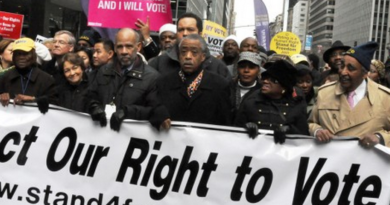Pathway to Citizenship for Minority Immigrants in the United States of America
By Imanche, Sunday Adiyoh 2/02/2024
The path to citizenship in the United States of America is a complicated and multi-step process that enables those who are not citizens of the country to become lawful residents of the country and eventually become citizens of the country. As a result of the United States’ long history of immigration, millions of individuals from all over the world have come to the United States in the hopes of starting a new life in the land of opportunity. Individuals must successfully negotiate several processes, requirements, and legal procedures to achieve their objective of becoming full-fledged citizens of the United States of America. The process of getting citizenship in the United States requires several steps.
Rep. Ilhan Omar, D-Minn., has called for every illegal immigrant in the U.S. to have a pathway to citizenship.
“We must create a pathway to citizenship for all undocumented people living here,” Omar wrote.
The reason is that “immigrants get the job done,” Omar wrote with a heart emoji in one of her tweets.
The Pew Research Center estimated in April that the population of illegal migrants in the U.S. stabilized at 10.5 million in 2017. They also wrote that a rising share of illegal aliens came to the U.S. legally but overstayed their visas.
According to data from Customs and Border Protection (CBP), the agency “encountered 178,622 persons attempting entry” along the southwestern border in April of this year alone, up 3% from March.
Of the 178,622 people who were encountered at the southwestern border by CBP, the agency “expelled 111,714 individuals under Title 42.” This means that over 66,000 migrants remained in the country after coming over the border in April.
CBP has recorded almost 900,000 encounters through May for fiscal year 2021 alone. Fiscal year 2020 saw just over 405,000 encounters.
The acquisition of a green card, which is another name for a lawful permanent residency, is the initial step in the process of becoming a citizen of the United States. Because of this status, individuals who are not citizens of the United States can reside and work in the country permanently. A green card can be obtained in several different ways, such as through family sponsorship, employment sponsorship, refugee or asylum status, or the diversity visa lottery program through the United States Department of Homeland Security. Once a person has earned a green card, they are required to maintain their status by adhering to all of the laws and regulations that are associated with their residency.
After holding a green card for a certain period, typically five years, individuals become eligible to apply for U.S. citizenship through a process called naturalization. To qualify for naturalization, applicants must meet certain requirements, including being at least 18 years old, being able to speak, read, and write English, having a basic understanding of U.S. history and government, and demonstrating good moral character. Applicants must also have resided continuously in the U.S. for a specified time and be physically present in the country for a certain number of days each year.
To become a naturalized citizen of the United States, one must first apply to the United States Citizenship and Immigration Services (USCIS), attend an interview, pass a civics and English test, and then take an oath of allegiance to the United States of America. Applicants are given citizenship in the United States and become eligible to acquire a certificate of naturalization once these prerequisites have been satisfied. Citizenship in the United States grants individuals the right to vote, the ability to hold public office, the ability to serve on juries, the ability to travel with a United States passport, and a variety of other benefits and obligations that are reserved for citizens.
The pathway to citizenship in the United States is not without challenges and obstacles. The immigration system is often criticized for being slow, bureaucratic, and difficult to navigate. Many immigrants face long wait times, backlogs in processing applications, high fees, complex legal requirements, and uncertainty about their status. In recent years, there have been debates and controversies surrounding immigration policy, border security, refugee admissions, and pathways to citizenship for undocumented immigrants.
Millions of individuals have completed the process of obtaining citizenship in the United States and are now proud to call themselves Americans, notwithstanding these obstacles. Immigrants’ contributions to the nation’s strength and vitality are enhanced by the cultural diversity, varied identities, and life experiences that they bring to the table. Maintaining the principles of opportunity, diversity, and inclusiveness that have historically characterized the American ideal while recognizing the contributions immigrants make to the nation is crucial as the debate over immigration reform continues.
The complex phenomenon of unauthorized immigration to the United States is impacted by a multitude of factors. Irrespective of the dangers and difficulties involved, individuals migrate illegally to the United States for a variety of motives. Illegal migration to the United States is motivated by a variety of factors, including the absence of legal migration routes, economic opportunities, family reunification, refuge from persecution and violence, and environmental concerns.
The process of obtaining citizenship in the United States demands effort, tenacity, patience, and compliance with legal regulations. By adhering to the specified procedures and meeting the required qualifications, individuals can attain their objective of becoming full-fledged members of American society with all the privileges and duties that citizenship involves.



The multi-step procedure for becoming a citizen of the United States of America is complex. The goal is to make it possible for those who aren’t citizens to live in the country legally and, in the long run, become citizens. The United States has a long and storied history of immigration, and millions of individuals from all over the globe have come here in quest of opportunity. To become a full citizen of the United States of America, one must complete some formalities and adhere to several regulations. To become a citizen of the United States, one must follow a series of steps. Immigrants from minority groups are bearing the brunt of this.